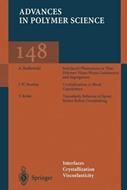Interfaces Crystallization Viscoelasticity
Epoxy resins are regarded as thermosetting resins and have found various c- mercial applications after crosslinking with adequate curing agents [1–3]. H- ever, some epoxy resins have been used as thermoplastic resins without curing agents. Figure 1 shows the applications of epoxy resins that are classi?ed to three categories: thermosets in combination with curing agents, thermoplastics wi- out curing agents, and raw materials for modi?cation. The use in thermoplastics is not popular compared with the two other applications. Typical thermoplastic applications are found in stabilizers for vinyl resins, toners for copying - chines, ?re retardants for engineering plastics, and sizing material for glass or carbon ?bers. The epoxy resin most frequently used is the oligomer of the diglycidyl ether of bisphenol-A (DGEBA) whose chemical structure is shown below [1–3]. The DGEBA is composed of linear molecules with different molecular weights according to the variation of the repeated number (n) in the structural formula.
-
Editore:
-
Collana:Advances in Polymer Science
-
Anno:2013
-
Rilegatura:Paperback / softback
Le schede prodotto sono aggiornate in conformità al Regolamento UE 988/2023. Laddove ci fossero taluni dati non disponibili per ragioni indipendenti da Feltrinelli, vi informiamo che stiamo compiendo ogni ragionevole sforzo per inserirli. Vi invitiamo a controllare periodicamente il sito www.lafeltrinelli.it per eventuali novità e aggiornamenti.
Per le vendite di prodotti da terze parti, ciascun venditore si assume la piena e diretta responsabilità per la commercializzazione del prodotto e per la sua conformità al Regolamento UE 988/2023, nonché alle normative nazionali ed europee vigenti.
Per informazioni sulla sicurezza dei prodotti, contattare productsafety@feltrinelli.it



